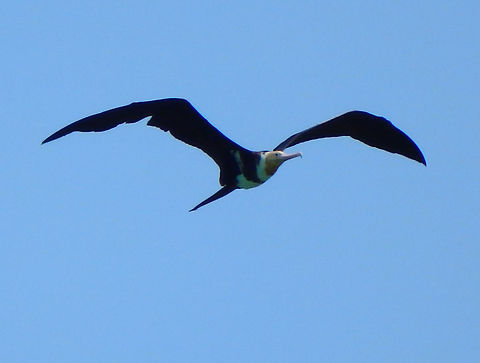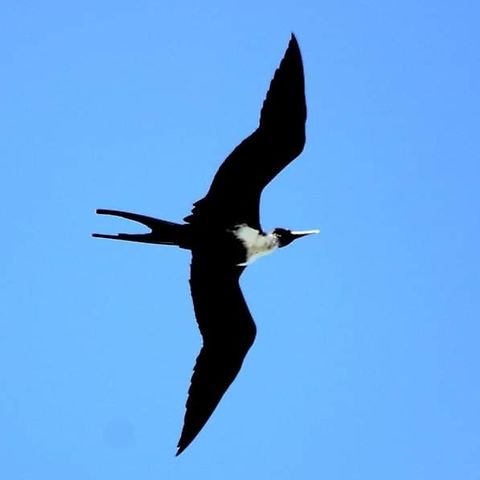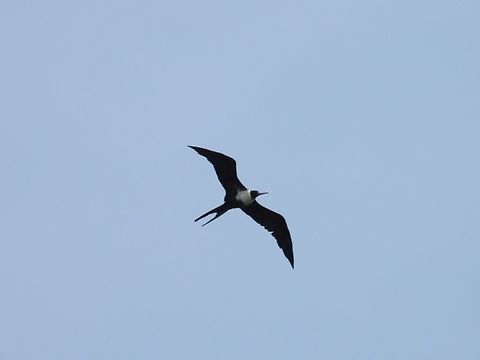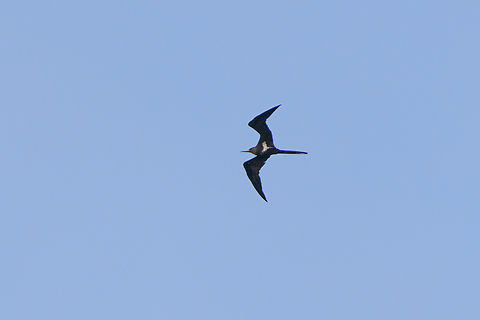
Appearance
The lesser frigatebird is the smallest species of frigatebird and measures 66–81 cm in length with a wingspan of 155–193 cm and long forked tails. Male birds weight 625–875 g. Female birds are heavier and weight 760–955 grams. Like all frigatebirds the male has a large red sac on the front of the throat which is inflated during courtship. Courtship display also involves a variety of calls, bill rattling and spreading of the wings. The male is mostly all black save for a white patch on the flank which extends on to the underwing as a spur. Males also have a pale bar on the upper wing. Females have a black head and neck with a white collar and breast as well as a spur extending on to the underwing. The female also has a narrow red ring around the eye. Juveniles and immature birds are more difficult to differentiate but the presence of the spurs of white in the armpits is a helpful distinguishing sign.Frigate birds are built for flying; they rarely swim and cannot walk but can manage to climb around the trees and bushes in which they nest. They have a very light skeleton and long narrow wings and are masters of the air. Their name probably derives from the fact that they harass other sea birds such as boobies and tropicbirds as they return to their nests from feeding, forcing them to disgorge their catch, which is then swooped upon and caught by the frigate birds before it reaches the water below. This practice seems to be more common among female frigate birds, but probably only accounts for a fairly small proportion of the diet, which mainly consists of squid and flying fish scooped up from the surface of the sea.

Naming
Three subspecies are recognised:⤷ "F. a. ariel" occurs in the central and eastern Indian Ocean, the seas off South East Asian and from northern Australia to the west and central Pacific Ocean.
⤷ "F. a. iredalei" named by the Australian ornithologist Gregory Mathews in 1914. It occurs in the western Indian Ocean and breeds on the Aldabra atoll.
⤷ "F. a. trinitatis" was named by the Brazilian zoologist Alípio de Miranda-Ribeiro in 1919. It occurred in the South Atlantic off the coast of Brazil and bred on the island of Trindade but may now be extinct.
Some ornithologists have questioned the validity of these subspecies as they appear to differ only in their size....hieroglyph snipped...

Distribution
The lesser frigatebird is said to be the most common and widespread frigatebird in Australian seas. It is common in tropical seas, breeding on remote islands, including Christmas Island in the Indian Ocean in recent years. These birds are most likely to be seen from the mainland prior to the onset of a tropical cyclone, and once this abates they disappear again.
Status
The total world population is estimated to be several hundred thousand birds. At least 6,000 pairs breed on the Aldabra Islands in the Indian Ocean and another 15,000 pairs breed on islands off the north coast of Australia. The largest colonies are on the Phoenix Islands and Line Islands in the central Pacific Ocean. Nests placed on the ground are very vulnerable to predation by introduced species such as feral cats. The elimination of cats from Howland, Baker and Jarvis Islands has led to the reestablishment and growth of colonies. Baker Island had no nesting lesser frigatebirds in 1965 but after the elimination of the feral cats on the island in around 1970 the birds returned and in 2002 16,200 individuals were recorded.A south Atlantic population of lesser frigatebirds once bred on the archipelago of Trindade, 1,100 km east of Brazil. The main island was once covered in forest but after this was destroyed, overgrazing by the introduced goats prevented any recovery. A series of eradication programs in the second half of the 20th century eliminated all the introduced vertebrates other than house mice. Feral cats that had seriously depleted ground nesting birds were finally eradicated in 1998. In 1975-1976 the American ornithologist Storrs Olson visited the island and reported seeing a small colony of 15 nests on a rocky islet just off the coast. Since this date there have been no further reports of lesser frigatebirds nesting on the island.
Because of the large population and extended range the species is classified by the International Union for Conservation of Nature as being of "Least Concern".

Reproduction
Breeding seems to occur between May and December in the Australian region. They nest in trees and both sexes contribute to nest building and incubation and feeding of the young. One egg is laid which takes 6–7 weeks to hatch. Fledglings are not left alone for another seven weeks or so for fear that they may be attacked and eaten by other birds including other frigate birds. They remain in the nest for another 6 months or so until fledged but they are cared for and fed by their parents for quite a long time after that.References:
Some text fragments are auto parsed from Wikipedia.